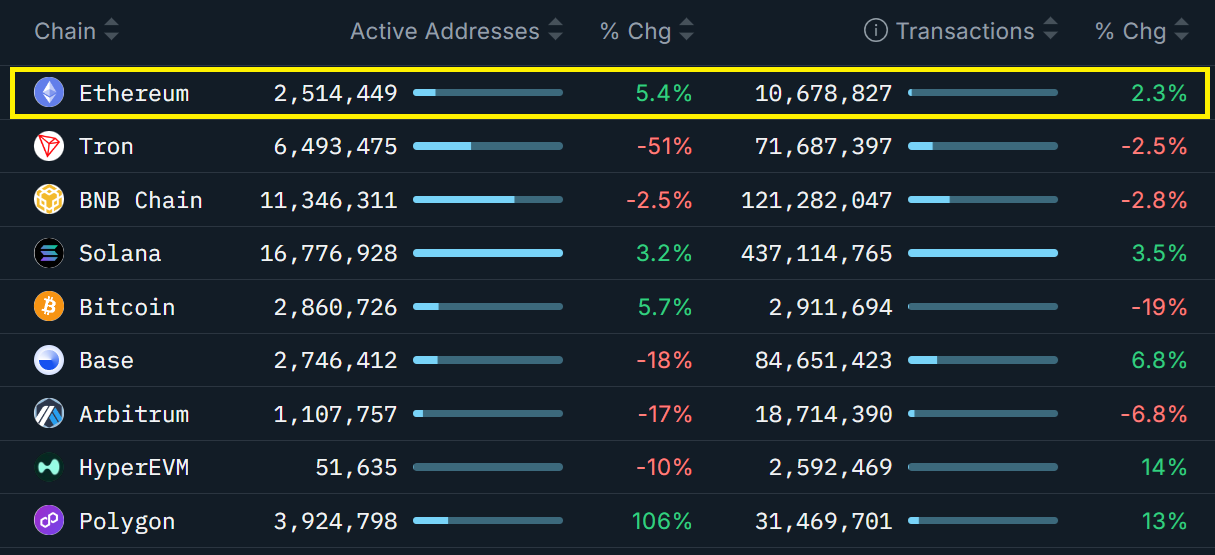
Weak demand for Ethereum exchange-traded funds (ETFs), soft derivatives performance, and macroeconomic concerns have caused Ethereum (ETH) to struggle to maintain a price of $3,400, even with stable on-chain activity.
Key Insights:
- Outflows from Ethereum ETFs and cautious sentiment among traders indicate limited confidence in short-term price increases.
- Low derivatives premiums point to a subdued outlook for Ether’s future price.
ETH experienced an 11% decline over the past week, following a drop from a Saturday high of $3,400. This downturn coincided with a 4% fall in the Nasdaq index, which reversed earlier gains. Traders are currently questioning whether ETH can reach the $3,900 mark again.
Concerns regarding global economic growth have risen due to disappointing quarterly results from consumer-focused companies and renewed worries about high valuations within the artificial intelligence sector. The ongoing US government shutdown is further straining the economy.
 ETH futures annualized premium. Source: laevitas.ch
ETH futures annualized premium. Source: laevitas.ch
Ethereum futures are currently trading at a 4% premium over spot markets, reflecting a lack of enthusiasm for buying positions, although it hasn’t reached alarming levels yet. Generally, such premiums range from 5% to 10% to accommodate for longer settlement durations.
Market anxiety has intensified following the latest University of Michigan survey, which revealed that US consumer sentiment expectations have dropped to record lows. The November readings represent the second-lowest since at least 1978, primarily attributed to the ongoing US government spending shutdown.
 ETH/USD compared to Total cryptocurrency capitalization. Source: TradingView
ETH/USD compared to Total cryptocurrency capitalization. Source: TradingView
Investors are frustrated due to ETH’s 4% weekly underperformance relative to the overall cryptocurrency market. This pattern suggests that in addition to growing macroeconomic risks, other elements may be making traders hesitant toward Ethereum.
 Total value locked on Ethereum, USD. Source: DefiLlama
Total value locked on Ethereum, USD. Source: DefiLlama
The total value locked (TVL) in the Ethereum network has dropped to $74 billion, its lowest since July, marking a 24% decline over the past month. Investors were surprised after one of Ethereum’s major decentralized finance (DeFi) platforms, Balancer v2, suffered a $120 million exploit.
 Ethereum DApps monthly revenue, USD. Source: DefiLlama
Ethereum DApps monthly revenue, USD. Source: DefiLlama
In October, revenues from Ethereum decentralized applications (DApps) fell to $80.7 million, a drop of 18% compared to September. This trend is especially alarming for ETH holders, as reduced on-chain activity affects the native staking yield negatively.
Ethereum’s Mechanism
Ethereum has an underlying system that burns ETH during times of heightened demand for blockchain data processing, aiding in the balance of network activity and supply.
 Active Ethereum addresses and transactions over 7 days. Source: Nansen
Active Ethereum addresses and transactions over 7 days. Source: Nansen
The first week of November showed positive signs for Ethereum in contrast to competing blockchains, with active addresses increasing by 5% and transactions by 2%. In comparison, both Tron and BNB Chain reported declines in their on-chain activities.
 Ethereum ETF daily flows, USD. Source: CoinGlass
Ethereum ETF daily flows, USD. Source: CoinGlass
Trader sentiment around ETH has been diminished by the lack of interest in Ethereum spot ETFs, which recorded $507 million in net outflows in November, alongside a lack of significant ETH purchases by corporate reserves.
The only notable catalyst for ETH currently is the upcoming Fusaka upgrade, expected in early December, which aims to introduce various scalability and security improvements to the network.
However, with futures markets indicating weakness and investor caution due to a slowing global economy, the likelihood of a breakout toward $3,900 in the foreseeable future seems uncertain.



